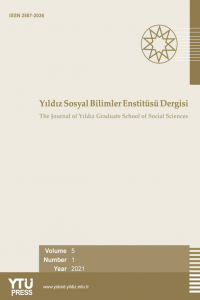İşletmelerde Çalışanların Psikolojik Güvenliği ve Psikolojik Güvenliğin Örgütsel Çıktı Olan İşe Angaje Olmaya Etkisi
Abstract
Bu araştırmada; bilgi gizleme, psikolojik güvenlik ve işe angaje olma arasındaki ilişkilerin incelenmesi amaçlanmıştır.
Çalışmada ilk olarak kavramlar incelenmiş ve geniş literatür taraması yapılmıştır. Literatür taramasının ardından araştırma modeli ve hipotezler geliştirilmiştir. Sonraki aşamada kavramlar arasındaki ilişkiler nicel yöntemler kullanılarak ampirik bir araştırma yapılmıştır. Bu bağlamda sosyal bilimlerde sıklıkla kullanılan anket tekniğinden faydalanılmıştır. Araştırmada literatürde var olan ölçekler kullanılmıştır. İlgili anket çalışması çeşitli yaş ve meslek gruplarından 500’den fazla kişiye ulaştırılmıştır. Ankete 324 kişiden geri dönüş sağlanmıştır. Ölçeklerin geçerlik ve güvenirlik analizleri gerçekleştirildikten sonra kavramsal model test edilmiştir.
Çalışmanın sonuçları bilgi gizleme ve psikolojik güvenlik ile bilgi gizleme ve işe angaje olma değişkenlerinin negatif ilişkili olduğunu, psikolojik güvenlik ve işe angaje olmanın pozitif ilişkili olduğunu göstermektedir. Ayrıca psikolojik güvenlik iki değişken arasında aracı etkisi görmektedir.
References
- Alavi M. & Leidner D.E. (2001). Review: Knowledge management and knowledge managament systems: Conceptual foundations and research issues. MIS Quarterly, 25 (1), 107-136.
- Bandura, A. (1977). Social Learning Theory. New York: General Learning Press.
- Burmeister A., Fasbender U. & Gerpott F.H. (2019). Consequences of knowledge hiding: The differential compensatory effects of guilt and shame. Journal of Occupational and Organizational Psychology, 92, 281–304.
- Connelly C.E. & Kelloway E.K. (2001). Predictors of Employees’ Perceptions of Knowledge Sharing Cultures. Working Paper, 01-06.
- Connelly C.E., Zweig D., Webster J. & Trougakos J.P. (2012). Knowledge hiding in organizations. Journal of Organizational Behavior, 33, 64–88.
- Černe M., Nerstad C.G.L., Dysvık A. & Škerlavaj M. (2014). What goes around comes around: Knowledge hiding, perceived motivational climate, and creativity. Academy of Management Journal, 1-52.
- Chen C.Y., Yen C.H. & Tsai F.C. (2014). Job crafting and job engagement: The mediating role of person-job fit. International Journal of Hospitality Management, 37, 21-28.
- Connelly C.E., Černe M., Dysvik A. & Škerlavaj M. (2019). Understanding Knowledge Hiding in Organizations. Journal of Organizational Behaviour, 40, 779-782.
- Davenport T. H. & Prusak L. (1998). Working Knowledge: How Organizations Manage What They Know. Boston: Harvard Business School Press.
- Emerson R.M. (1976). Social exchange theory. Annual Review of Sociology, 2, 335-362.
- Edmondson A. (1999). Psychological safety and learning behavior in work teams. Administrative Science Quarterly, 44 (2), 350-383.
- Edmondson A.C. (2002). Managing the risk of learning: Psychological safety in work teams. International Handbook of Organizational Teamwork, London: Blackwell.
- Edmondson A.C. & Mogelof J.P. (2004). Explaining psychological safety in innovation teams: Organizational culture, team dynamics, or personality?. In Thompson L.L. and Choi H.S. (Eds.) Creativity and innovation in organizational teams, 109-136, Mahwah, NJ:Lawrence Erlbaum Associates, Inc.
- Edmondson A. C. (2004). Psychological safety, trust, and learning in organizations: a group-level lens. In Trust and Distrust in Organizations: Dilemmas and Approaches. Kramer RM, Cook KS (eds). Russell Sage Foundation. New York: 239-272.
- Inceoglu I. & Warr P. (2012a). Personality and job engagement. Journal of Personnel Psychology, Journal of Occupational Health Psychology, 10 (4), 177-181.
- Inceoglu I. & Warr P. (2012b). Job engagement, job satisfaction, and contrasting associations with person-job fit. Journal of Occupational Health Psychology, 17 (2), 129-138.
- Jiang Z., Hu X., Wang Z. & Jiang X. (2019). Knowledge hiding as a barrier to thriving: The mediating role of psychological safety and moderating role of organizational cynicism. Journal of Organizational Behavior, 40, 800–818.
- Kahn W.A. (1990). Psychological conditions of personal engagement and disengagement at work. Academy of Management Journal, 33 (4), 692-724.
- Kelloway E. K. & Barling J. (2000). Knowledge Work as Organizational Behavior, International Journal of Management Reviews, 287-304.
- Maslow A. H. (1943). A theory of human motivation. Originally Published in Psychological Review, 50, 370-396.
- Maslach C., Schaufeli W.B. & Leiter M.P. (2001). Job burnout. Annual Review of Psychology, 52, 397–422.
- May D.R., Gilson R.L. & Harter L.M. (2004). The psychological conditions of meaningfulness, safety and availability and the engagement of the human spirit at work. Journal of Occupational and Organizational Psychology, 77, 11–37.
- Macey W.H. & Schneider B. (2008). The meaning of employee engagement. Industrial and Organizational Psychology, 1, 3–30.
- Nunnally J.C. (1978). Psychometric Theory. 2nd Edition, McGraw‐Hill.
- Offergelt F., Spörrle M., Moser K. & Shaw J.D. (2018). Leader‐signaled knowledge hiding: Effects on employees' job attitudes and empowerment. Journal Organizational Behaviour, 40, 819–833.
- Peng H. (2013). Why and when do people hide knowledge?. Journal of Knowledge Management, 17 (3), 398-415.
- Rich B.L., Lepine J.A. & Crawford E.R. (2010). Job engagement: Antecedents and effects on job performance. Academy of Management Journal, 53 (3), 617–635.
- Schein E.H. (1992). How can organiations learn faster? The problem of entering the green room. Working paper, 3409-92.
- Saks A.M. (2006). Antecedents and consequences of employee engagement. Journal of Managerial Psychology, 21 (7), 600-619.
- Schoorman F.D., Mayer R.C. & Davis J.H. (2007). An integrative model of organizational trust: Past, present, and future. The Academy of Management Review, 32 (2), 344-354.
- Schaufeli W. (2013). What is engagement?. Employee Engagement in Theory and Practice, London: Routledge, 3-37.
- Skerlavaj M., Connelly C.E., Cerne M. & Dysvik A. (2018). Tell me if you can: Time pressure, prosocial motivation, perspective taking, and knowledge hiding. Journal of Knowledge Management, 22 (7), 1489-1509.
- Webster J., Brown G., Zweig D., Connelly C.E., Brodt S. & Sitkin S. (2008). Beyond knowledge sharing: Withholding knowledge at work. Research in Personnel and Human Resources Management, 27.
Details
| Primary Language | Turkish |
|---|---|
| Journal Section | Makaleler |
| Authors | |
| Publication Date | September 15, 2021 |
| Published in Issue | Year 2021 Volume: 5 Issue: 1 |

